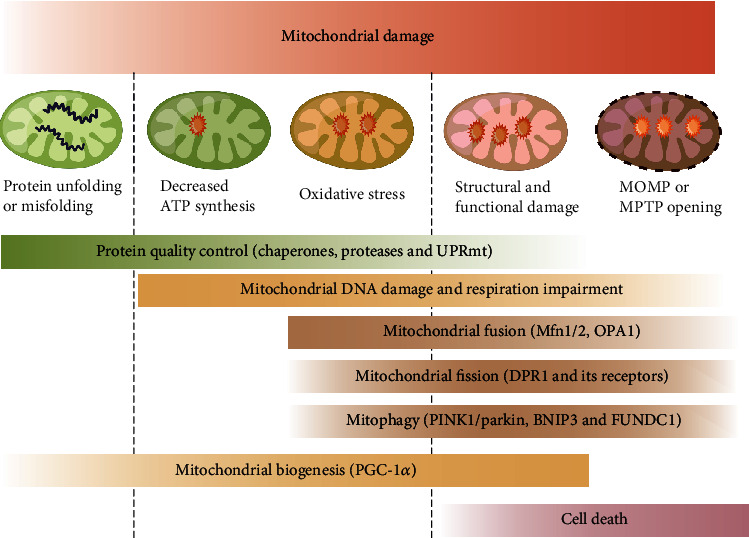Figure 4.

Mitochondrial quality control system. The mitochondrial quality control system includes both molecular and organelle quality control mechanisms. In the case of unfolded or misfolded proteins, protein quality control exerts actions mainly through chaperones which catalyze protein folding and ATP-dependent proteases which remove damaged proteins. When the protein quality control system is overloaded, the mitochondrial unfolded protein response (UPRmt) is activated. Signals from mitochondria are reversely transmitted to the nucleus to induce transcription of genes encoding mitochondrial chaperones, which subsequently enhances protein-folding capacity. Moderate mitochondrial stress is also accompanied by reduced ATP production and enhanced mitochondrial oxidative stress. DNA damage repair mechanisms are subsequently activated and function to repair damaged mitochondrial DNA. As mitochondrial injury becomes aggravated, severe mitochondrial stress triggers a series of alterations in mitochondrial structure and function, including mitochondrial fusion regulated by mitofusin 1 (Mfn1), mitofusin 2 (Mfn2), and optic atrophy 1 (OPA1); mitochondrial fission activated by cytosolic dynamin-1-like protein (Drp1); and its receptors. Daughter mitochondria resulting from segregation of damaged mitochondria are then targeted for degradation via mitophagy with specific adaptors such as Parkin, BCL-2/adenovirus E1B 19 kDa protein-interacting protein 3 (Bnip3), and FUN14 domain-containing 1 (Fundc1). Due to excessive mitochondrial fission, the reticular mitochondrial network is converted into fragmented mitochondria, which may reduce ATP production. Coupled with excessive mitophagy, the reduced mitochondrial mass results in impaired mitochondrial biogenesis, further leading to cellular bioenergetic crises. Daughter mitochondria can still be synthesized by the mitochondrial biogenesis process regulated by transcription factors like peroxisome proliferator-activated receptor-γ co-activator 1α (PGC-1α) but hindered production of nascent mitochondria eventually leads to cell death.
